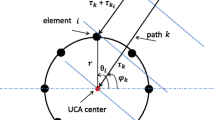Abstract
Diversity techniques have been extensivelyconsidered for application in propagation media,examining various combining schemes, to mitigate theeffects of short-term fading probability andconsequently to reduce the required fading margin.Narrowband propagation measurements were conductedwithin a four-story building at Technical University ofAthens under a number of different radio pathconditions, using a dual-channel-receiving unit, consistingof two spectrum analyzers, controlled by a personalcomputer. This paper presents the results of indoorradio propagation using space and cross-polarization diversity measurements in an indoor wirelessradio channel at 1.8 GHz. Moreover, the diversity gainat 99% signal reliability level and correspondingcross-correlation coefficients have been estimated by considering selection and maximalratio-combining diversity schemes. The results are veryimportant for system designers of indoor communicationsystems, involving data transmission on wireless mobilenetworks. A detailed description of the measurementenvironment and experimental setup is given. From themeasurements collected, the parameters of power decayfactor and temporal fading signal statistics were also estimated and analyzed.
Similar content being viewed by others
REFERENCES
W. C. Jakes, Microwave Mobile Communication s.New York: Wiley, 1974.
S. R. Todd, M. S. El-Tanany, and S. A. Mahmoud, Space and frequency diversity measurements of the 1.7 GHz indoor radio channel using a four-branch receiver, IEEE Transactions on Vehicular Technology, Vol. 41, No.3, August 1992, pp. 312–320.
M. S. Smith and L. Neal, A Comparison of Polarization and Space Diversity for Indoor Propagation at 900 MHz, 2nd ICUPC, Ottawa, Canada, 1993, pp. 74–78.
Bergljung, Borjesson, Fauulkner, Huaiyuan, Jonhsson, Karlsson, Mizuko, Olsson, and Ohrvik, Microcell Channel. Preliminary Report on Indoor Field-Strength Measurements at 900 and 1700 MHz.Applied Electronics, Lund University, REF: RMTP/ RB/ J031, Jan. 1989.
W. C. Y. Lee, Polarization diversity system for mobile radio, IEEE Transactions on Communication, Vol. COM-20, No.5, Oct. 1972, pp. 912–923.
H. Hashemi, M. McGuire, T. Vlasschaert, and D. Tholl, Measurements and modeling of temporal variations of the indoor radio propagation channel, IEEE Transactions on Vehicular Technology, Vol. 43, No.3, Aug. 1994.
A. J. Motley and S. E. Alexander, Diversity advantage for cordless telephones, Electronics Letters, Vol. 19, July 7, 1983, pp. 531–533.
J. Lemieux, M. S. Tanany, and S. A. Mahmoud, Experimental evaluation of space/frequency/ polarization diversity in the indoor wireless channel, IEEE Transactions on Vehicular Technology, Vol. 40, No.3, Aug. 1991, pp. 569–574.
S. A. Bergmann and H. W. Arnold, Polarization diversity in portable communications environment, Electronics Letters, Vol. 22, No.11, May 1986, pp. 609–610.
S. J. Howard and K. Pahlavan, Fading Results from Narrowband Measurements of the Indoor Radio Channel, 2nd PIMRC, September 1991, London, pp. 92–97.
W. A. McGladdery and S. Stapleton, Investigation of polarization effects in indoor radio propagation, Proc. ICWC, 1992, No. 3.1, pp. 53–56.
A. Turkmani, A. Arowojolu, P. Jefford, and C. Kellet, An experimental evaluation of the performance of two branch space and polarization diversity schemes at 1800 MHz, IEEE Transactions on Vehicular Technology, Vol. 44, No.2, May 1995, pp. 318–327.
P. H. Lehne and M. Pettersen, Space Diversity for DECT in Indoor and Outdoor Microcells, 7th PIMRC, Taipei, Taiwan, October 1996.
A. AbouRaddy and S. M. Elnoubi, Propagation measurements in an indoor wireless mobile environment at 10 GHz, IEEE Computers and Communications Symposium, Alexandria, Egypt, July 1997, pp. 561–565.
P. E. Mogensen and S. Pettersen, Practical considerations of using antenna diversity in DECT, 44th IEEE Vehicular Technology Conference (VTC-94), Stockholm, Sweden, pp. 1532–1536.
M. Murase, Y. Tanaka, and H. Arai, Propagation and antenna measurements using antenna switching and random field measurements, IEEE Transactions on Vehicular Technology, Vol. 43, No.3, August 1994.
Rights and permissions
About this article
Cite this article
Papadakis, N., Stavropoulos, I., Xirotsopanos, E. et al. Space and Polarization Diversity Measurements in an Indoor Radio Environment at 1800 MHz Using a Dual-Channel Receiver. International Journal of Wireless Information Networks 5, 103–113 (1998). https://doi.org/10.1023/A:1018861317834
Issue Date:
DOI: https://doi.org/10.1023/A:1018861317834




